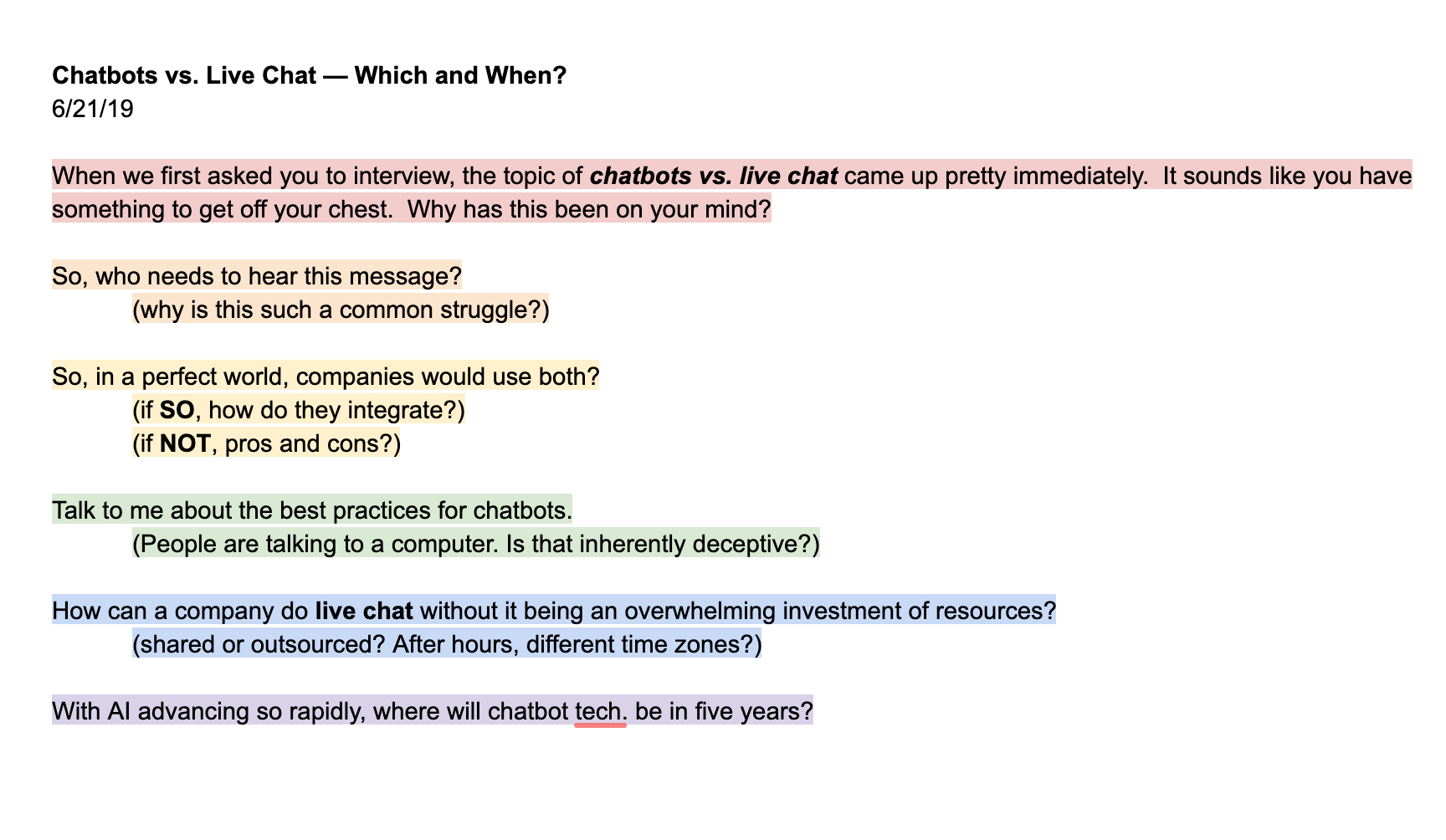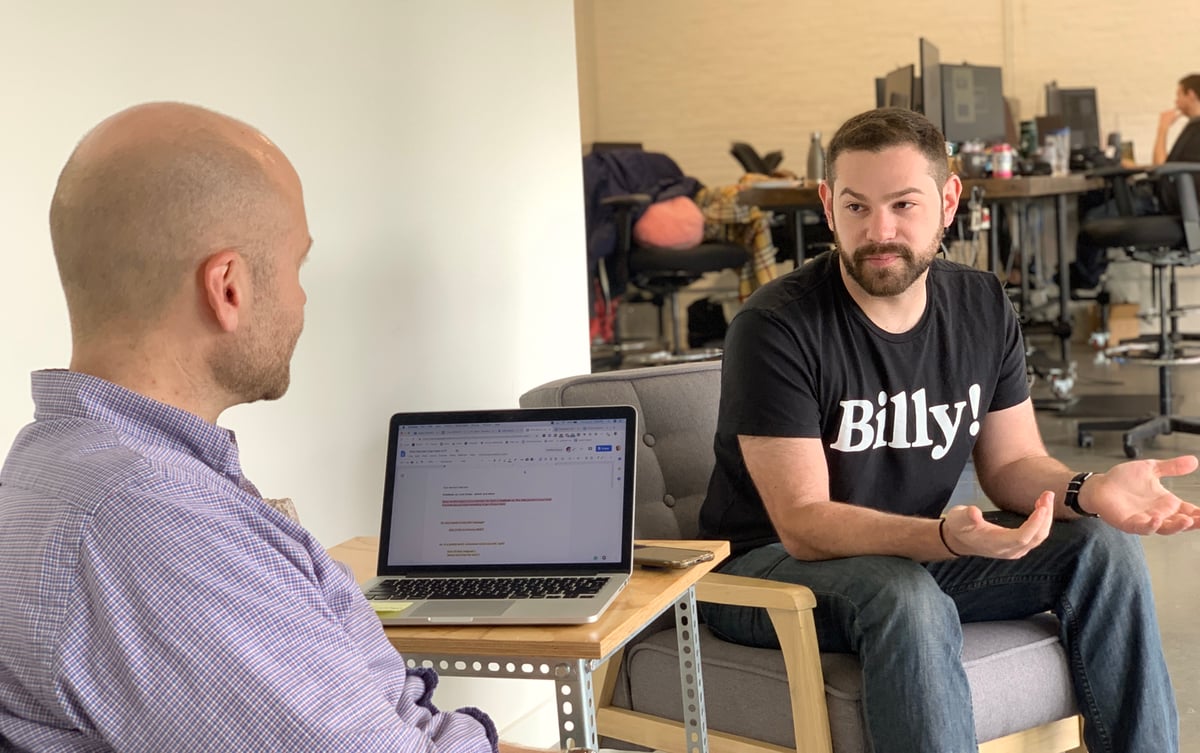Join 40,000+ sales and marketing pros who receive our weekly newsletter.
Get the most relevant, actionable digital sales and marketing insights you need to make smarter decisions faster... all in under five minutes.
Imagine this:
You’re interviewing someone you’ve never met about a business blog topic you’re unfamiliar with, and you’re doing this over the phone with bad reception. The person is a C-level executive at a company that’s hired your agency. She is hard to hear, frequently spouts jargon, and the sound cuts out at key moments. She has a tendency toward one-word answers and started out by telling you she’s in a rush. You’re not even sure if she heard the entirety of your last question — and your phone battery is dying.
Before you get second-hand stress, know that your interviews are likely to never be that bad. Granted, some will go better than others, but you can often control many of the aspects that go into a successful interview.
To me, planning for an interview is like planning a dinner party.
The interview itself — that’s the dinner. Obviously, most of your effort goes into getting this right. However, there are a host of other details that come before and after that are equally important.
In order for dinner to go well, everything up to that point has to have been carefully planned, starting with the invitation.
Similarly, after dinner comes dessert and drinks — and, after people leave — clean-up, thank you cards, and social media posts.
You want it all to go well.
The Invitation
Chances are, you’re probably interviewing someone you’ve at least met before.
If it is someone whom you’ve never met, send out an early message that introduces yourself and allows the person to feel in control of the details.
In either case, start communicating early. If it’s someone you know, a quick hello and reminder is appropriate, along with an invitation to collaborate on interview structure.
Does he want to see questions in advance? Does she want to create questions herself? Are there any protocols he wants in place?
Clarifying these details makes your subject feel more at ease — but it also helps you prepare.
An interview in which all of the questions are confirmed beforehand requires extensive polishing and preparation.
This is the equivalent of a formal dinner menu. More of the work comes on the front-end. There are fewer unexpected twists and turns. If you’ve shared the menu in advance, there’s little chance that someone won’t like a dish.
An interview that’s formatted as a general topic with “prompt”-type questions requires a bit less preparation up front, but more effort during and after.
This is the equivalent of a dinner of tapas. One dish might be a hit, one might be a dud. Be ready to pivot and adapt. There’s a chance your guests won’t like something, but there’s a wonderful chance that something else will be totally and genuinely exciting.
And that’s pure magic.
The Decorations
In a recent episode of Liz Murphy’s Content Lab Podcast, I spoke about the importance of controlling the architecture of an interview.
In my experience, the best interviews are conversations.
When we think of “interview” all of the worst emotions surface. We think of applying for a job or trying to get into college. We think of an architecture that suggests adversaries. One person here, one person there, a desk between them. A clipboard, a pen.
Conversations, by contrast, are cherished interactions.
If you can, set up the space to be comfortable. Angle chairs toward each other instead of directly facing each other. Put out snacks or water. Remind the person that breaks are welcome.
If you’re doing this over a video or phone call, ask the person to find a spot in the office, home, or co-working space that makes her feel comfortable.
Planning the Menu
When I plan an interview, I tend to write a list of questions (and sub-questions) that follow the path I think the conversation might follow. If I’m planning a short interview, this might be only three or four questions. More likely, it’s between five and eight.
I see questions as points of departure.
I want to be ready if some of my questions don’t land, or if others lead down interesting tangents. It’s cliche to say “prepare for the unexpected,” but I think preparing yourself to be adaptable is a sound strategy.
I recently conducted an interview with Nick Bennett about the functionality of chatbots and the cost of operating a live chat. I sent him the following questions in advance:

color-coding helps
The Arrival
When guests arrive for a dinner party, you greet them, take their coats, offer drinks and hors d’oeuvres.
In an interview, banter beforehand goes a long way to making a person feel relaxed and poised. Before you start recording, make sure the person is comfortable about the process. If she wants to go over any questions or procedures, now’s the time.
The recorded interview should be a formal portion of a longer conversation that does not start when you press record or end when you stop recording.
It is, to me, a shared performance that contains acknowledged artifice. After all, you are each playing a role.
But you should do everything you can to make the interview feel genuine.
The Dinner
When I was a writing teacher, I would assign a This American Life-style radio essay project. In essence, students would pitch, write, perform, record, and produce digital tracks that combined a written script with music and sound effect. My most pressing instruction was this: you must make people like you.
You can hear a smile in a voice, I believe. In person, it’s even easier. Make your subject feel that you are valuing your time together, and that you are generally interested in what is being discussed.
Make your subject like you. This calls upon different skills in each interviewer, but the result should be the same.
Hopefully, the preparation you’ve done will create an environment that makes your subject feel comfortable, open, eager, and unhurried.
If the topic is niche or esoteric, I tend to start with a two-part standard question. I vary it to suit the situation, of course, but it’s often some form of “why do you want to talk about this particular subject?” and “Who do you think needs to hear this message?”
If not that, it’s an invitation to define terms.
Otherwise, I try to begin with an opening that feels welcoming and encouraging.
Prompt him to begin, and then be ready to adapt.
In a perfect world, your exchanges are effortless, your subject’s responses are effusive and complete, and you come to a natural stopping point with a few minutes to spare.
In the real world, you might stumble. Your subject might balk or be redundant.
At dinner, someone might spill wine or complain about the soup or bring up another guest’s divorce.
Someone might casually announce a peanut allergy.
If it happens, you deal with it.
In the interview, be nimble and ready to pivot. If a topic feels rich, be ready with a follow-up question. If you reach a dead end, be primed to shift gears and move in a new direction.
Just like in any human interaction, intuition and emotional intelligence are vital. Read the room, so to speak.
The Dessert
When you stop recording, immediately check in with (and congratulate) your subject.
How did that go? Were you comfortable? You did great!
Assuage any fears your guest might have. Assure him that his answers were thorough and thoughtful — and extend the opportunity to amend and add anything once he sees the transcripts.
The Next Day
After a party, you might reach out to thank people for coming. You should also thank your subject. For me, an informal message helps balance the structure of the interview itself: “Hey! Thanks so much for sitting down with me yesterday. I’ll forward you the transcript (or article) once I’ve cleaned it up!”
When you get the transcript back, you should first go through and clean out any redundancies, crosstalk, stammers, or pauses.
At this point, it depends what you’re hoping to do with the interview. In most cases, I will either be publishing a transcript or ghostwriting as my subject. In either case, the person should remain as a part of the process as much as is necessary.
If it’s the former, make sure to forward the transcript for the subject’s approval. This is especially important if you’ve done a good deal of compressing and trimming. It is possible to trim 50% or more of the actual transcript, so make sure the guest feels the final product is an accurate representation of his or her thoughts.
If it’s the latter, and you’re ghostwriting, try to incorporate the tone and as much of the text as possible into your article so that the person’s voice comes through.
Final Thoughts
There is no perfect formula for conducting an interview. Remember that the recorded portion represents the centerpiece of a much longer interaction — and do all you can to make it feel more like a conversation than an interview.
Some will go better than others, but the preparation you can do beforehand will hopefully yield an experience that’s genuine, pleasant, and memorable.
Free Assessment:

